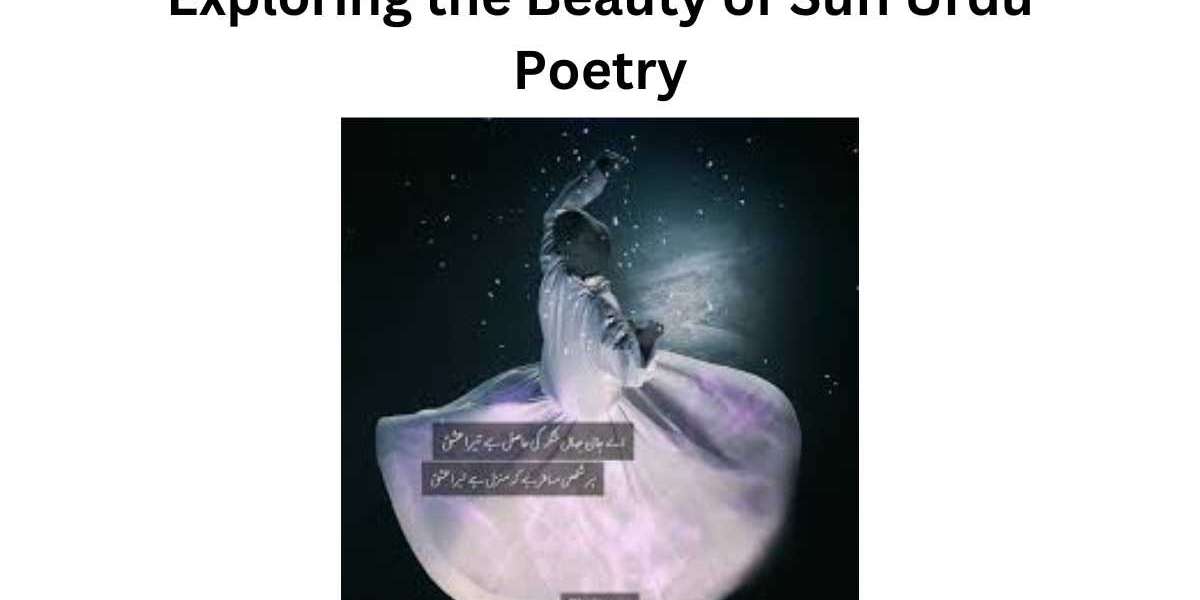Introduction
Welcome to the enchanting world of Urdu Poetry, where every word is a melody and every verse a journey into the depths of the soul. In this article, we will embark on a voyage through the rich tapestry of Sufi expression encapsulated in the mesmerizing verses of Urdu poetry.
Exploring the Rich History of Sufism
Sufism, often referred to as the mystical dimension of Islam, is a profound spiritual tradition that has deeply influenced cultures and societies across the globe. Originating from the teachings of the Prophet Muhammad, peace be upon him, Sufism delves into the esoteric aspects of Islam, emphasizing the inward journey towards spiritual enlightenment and closeness to the Divine.
Themes in Urdu Poetry
Urdu Poetry, with its rich tapestry of emotions and experiences, explores a myriad of timeless themes that resonate deeply with the human soul. At the heart of Urdu Poetry lies the theme of love, portrayed in all its forms - from the ecstasy of union to the agony of separation. Poets weave verses that capture the essence of devotion, longing, and desire, transcending the boundaries of time and space. Alongside love, themes of spirituality and mysticism permeate Urdu Poetry, as poets embark on a quest for deeper understanding and enlightenment. Through allegorical language and metaphorical imagery, they delve into the mysteries of existence, probing the depths of the soul in search of divine truths. Urdu Poetry also reflects the joys and sorrows of everyday life, portraying the triumphs and tribulations of human experience with profound empathy and insight. Whether celebrating the beauty of nature or lamenting the transience of life, Urdu Poetry serves as a mirror reflecting the myriad hues of the human condition, inviting readers to embark on a journey of self-discovery and contemplation.
Origins of Sufism
The roots of Sufism can be traced back to the early days of Islam, emerging as a response to the materialism and worldliness that began to permeate the Muslim community. Scholars often point to the teachings of renowned figures such as Rumi, Ibn Arabi, and Al-Ghazali as instrumental in shaping the foundations of Sufism. These luminaries espoused the importance of love, compassion, and inner purification as essential components of the spiritual path.
Philosophical Underpinnings
At its core, Sufism advocates for the concept of Tawhid, the oneness of God, and Tasawwuf, the purification of the soul. Sufi practitioners believe in the concept of dhikr, the remembrance of God through various spiritual practices such as chanting, meditation, and contemplation. Through these practices, adherents seek to transcend the limitations of the material world and attain union with the Divine.
Key Practices and Rituals
Sufism encompasses a wide array of spiritual practices designed to foster spiritual growth and self-realization. One of the central practices in Sufi tradition is Sama, or spiritual concert, where practitioners engage in devotional music and dance as a means of reaching ecstatic states of spiritual consciousness. Zikr, the repetition of sacred phrases or names of God, is another fundamental practice in Sufism, serving as a means of purifying the heart and drawing closer to the Divine.
Schools and Orders
Throughout history, Sufism has given rise to numerous schools and orders, each with its own distinct teachings and practices. From the Naqshbandiyya to the Chishtiya and the Qadiriyya, these Sufi orders have played a significant role in preserving and disseminating the teachings of Sufism across different regions and cultures. Each order is guided by a spiritual master, known as a shaykh, who imparts spiritual guidance and initiates disciples into the mystical path.
Influence on Art and Culture
The influence of Sufism extends far beyond the realm of spirituality, permeating various aspects of art, literature, and culture. Sufi poetry, with its themes of love, longing, and spiritual ecstasy, has captivated audiences for centuries, with luminaries such as Rumi and Hafiz leaving an indelible mark on world literature. Sufi music, characterized by its soul-stirring melodies and poetic lyrics, continues to inspire listeners around the globe, transcending cultural boundaries and fostering a sense of unity and belonging.
Sufism in the Modern World
In today's fast-paced and interconnected world, the teachings of Sufism remain as relevant as ever, offering solace and guidance to seekers in search of meaning and purpose. From bustling metropolises to remote villages, Sufi communities continue to thrive, preserving ancient traditions and imparting timeless wisdom to future generations. As humanity grapples with the challenges of the modern age, the message of Sufism - one of love, compassion, and spiritual awakening - serves as a beacon of hope and enlightenment.
Origins of Urdu Poetry
The roots of Urdu Poetry delve deep into the annals of history, intertwining with the cultural fabric of the Indian subcontinent. Emerging in the 13th century, Urdu Poetry blossomed as a fusion of various linguistic and literary traditions, including Persian, Arabic, and local dialects. It found its genesis in the courts of medieval rulers, where poets adorned the halls with verses that captured the essence of love, longing, and spiritual yearning. Over time, Urdu Poetry evolved into a distinct art form, reflecting the rich tapestry of the region's diverse cultural influences. Its lyrical beauty and emotive depth have continued to captivate audiences, transcending linguistic barriers to become a cherished treasure of humanity's literary heritage. Through the centuries, Urdu Poetry has remained a testament to the enduring power of human expression, weaving together the threads of history, tradition, and the collective human experience.
Sufism and Poetry
Within the mystical realms of Sufism, poetry emerges as a sublime vessel for expressing the ineffable truths of the soul. In the context of Urdu Poetry, Sufism infuses every verse with a sacred resonance, as poets delve into the depths of spiritual experience. Sufi poets, guided by the path of love and devotion, use the medium of Urdu Poetry to convey profound insights into the nature of existence and the divine. Through allegorical language and vivid imagery, they paint portraits of divine union, where the lover seeks reunion with the Beloved, symbolizing the soul's journey towards spiritual enlightenment. Each poem becomes a journey of self-discovery, inviting readers to explore the mysteries of the heart and the cosmos. In the embrace of Sufism, Urdu Poetry transcends the mundane and touches the sublime, offering solace to weary souls and guiding them towards the light of inner illumination.
Major Sufi Poets
In the realm of Urdu Poetry, several luminaries stand tall as beacon lights of Sufi wisdom and lyrical brilliance. Among these revered figures are Mir Taqi Mir, whose verses pulsate with profound introspection and existential longing. Mir's poetry transcends the mundane, offering glimpses into the divine through the lens of human experience. Another towering figure is Ghalib, whose intricate ghazals intertwine love, mysticism, and philosophical musings with unparalleled elegance. Ghalib's mastery of language and imagery continues to inspire generations of poets and aficionados alike. Allama Iqbal, often hailed as the poet-philosopher of the East, infuses his poetry with a fervent call to awaken the dormant spirit of the soul. His verses resonate with the ethos of Sufi mysticism, urging listeners to transcend the shackles of ego and embrace the divine essence within. These major Sufi poets, through their timeless verses, have left an indelible mark on Urdu Poetry, enriching it with the depth of spiritual insight and the beauty of poetic expression.
Evolution of Urdu Poetry
In the realm of Urdu Poetry, several luminaries stand tall as beacon lights of Sufi wisdom and lyrical brilliance. Among these revered figures are Mir Taqi Mir, whose verses pulsate with profound introspection and existential longing. Mir's poetry transcends the mundane, offering glimpses into the divine through the lens of human experience. Another towering figure is Ghalib, whose intricate ghazals intertwine love, mysticism, and philosophical musings with unparalleled elegance. Ghalib's mastery of language and imagery continues to inspire generations of poets and aficionados alike. Allama Iqbal, often hailed as the poet-philosopher of the East, infuses his poetry with a fervent call to awaken the dormant spirit of the soul. His verses resonate with the ethos of Sufi mysticism, urging listeners to transcend the shackles of ego and embrace the divine essence within.
Influence on Literature
landscape of literature with profound impact. From the courts of medieval rulers to the modern literary salons, Urdu Poetry has left an indelible mark on the literary traditions of the Indian subcontinent. Its lyrical beauty and emotive depth have inspired not only poets but also novelists, playwrights, and scholars across generations. Urdu Poetry's rich themes of love, spirituality, and existential contemplation have served as fertile ground for exploration in other literary genres, shaping the narrative landscape of Urdu fiction and drama. Moreover, the exquisite language and intricate rhyme schemes of Urdu Poetry have influenced the stylistic choices of writers in other languages, fostering cross-cultural exchange and enriching the global literary tapestry. In essence, the influence of Urdu Poetry on literature transcends linguistic boundaries, serving as a testament to the enduring power of artistic expression to unite hearts and minds across diverse cultures and epochs.
Popular Forms of Urdu Poetry
Urdu Poetry boasts a diverse array of poetic forms, each with its own unique structure and aesthetic appeal. Among the most popular forms is the ghazal, characterized by its intricate rhyme scheme and profound imagery. Ghazals typically consist of couplets, or sher, linked by a common theme or emotion, offering poets a canvas to explore the depths of love, longing, and spiritual yearning.
Another prominent form is the qasida, a lyrical ode often used to praise patrons or celebrate significant events. Qasidas are marked by their elaborate language and formal structure, showcasing the poet's skill in composition and rhetoric.
Impact on Culture
Urdu Poetry boasts a diverse array of poetic forms, each with its own unique structure and aesthetic appeal. Among the most popular forms is the ghazal, characterized by its intricate rhyme scheme and profound imagery. Ghazals typically consist of couplets, or sher, linked by a common theme or emotion, offering poets a canvas to explore the depths of love, longing, and spiritual yearning.
Another prominent form is the qasida, a lyrical ode often used to praise patrons or celebrate significant events. Qasidas are marked by their elaborate language and formal structure, showcasing the poet's skill in composition and rhetoric.
Modern Urdu Poetry Trends
In the contemporary era, Urdu poetry continues to thrive, embracing new themes and experimental forms. Poets like Faiz Ahmed Faiz, Ahmed Faraz, and Parveen Shakir have redefined the boundaries of expression, addressing social and political issues with poignancy and grace.
Conclusion
The history of Sufism is a testament to the enduring power of the human spirit to transcend the limitations of the material world and attain union with the Divine. From its humble origins to its profound influence on art, culture, and spirituality, Sufism continues to inspire and uplift millions of souls around the globe. As we navigate the complexities of the modern world, may we draw wisdom from the rich tapestry of Sufi tradition and embark on our own journey towards spiritual fulfillment and inner peace.
Frequently Asked Questions (FAQs)
- What is the significance of Urdu poetry in Sufism?
- Urdu poetry serves as a medium for expressing the esoteric truths of Sufism in a language accessible to the masses, fostering a deeper understanding of spiritual concepts through the beauty of verse.
2. Who are some notable Sufi poets in Urdu literature?
Renowned Sufi poets in Urdu literature include Mir Taqi Mir, Ghalib, and Allama Iqbal, whose verses continue to inspire and uplift hearts across generations.
3. How has Urdu poetry influenced other art forms?
Urdu poetry has left an indelible mark on music, dance, and visual arts, with its lyrical beauty and profound themes serving as a source of inspiration for artists across disciplines.
4. What are the major themes explored in Urdu poetry?
Love, devotion, longing, and spiritual enlightenment are recurring themes in Urdu poetry, reflecting the universal human experiences of joy, sorrow, and transcendence.
5. Is Urdu poetry still relevant in the modern era?
Absolutely! Urdu poetry continues to evolve, addressing contemporary issues while retaining its timeless charm and universal appeal, thus remaining relevant in today's world.








